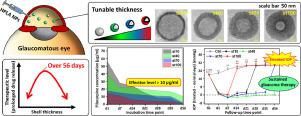Acta Biomaterialia ( IF 9.7 ) Pub Date : 2020-05-16 , DOI: 10.1016/j.actbio.2020.04.055 Duc Dung Nguyen , Li-Jyuan Luo , Jui-Yang Lai

|
Structural designing of carriers with extended drug release profiles is critically important for achieving long-acting drug delivery systems toward efficient managements of chronic diseases. Here, we present a strategy to exploit the effects of the shell thickness of hollow poly(lactic acid) nanoparticles (HPLA NPs) in sustained glaucoma therapy. Formulations based on pilocarpine-loaded HPLA NPs with tailorable shell thickness ranging from 10 to 100 nm were shown to be highly compatible with human lens epithelial cells in vitro and with rabbit eyes in vivo. Specifically, shell thickness regulated the release of pilocarpine, with thick shells (~70 to 100 nm) providing sustained drug release performance but limited drug-loading efficiency, whereas ultrathin shells (~10 nm) induced the opposite effects. Remarkably, moderately thick shells (~40 nm) showed the most effective release profile of pilocarpine (above the therapeutic levels of ~10 µg/mL for over 56 days). In a rabbit model of glaucoma, single intracameral administration of an HPLA NP-based formulation with shell thickness of ~40 nm sustainably alleviated ocular hypertension for over 56 days, consequently protecting the structural integrity of the corneal endothelium, preserving the electrophysiological functions of the retina, and attenuating retinal and optic nerve degeneration in progressively glaucomatous eyes. The findings therefore implied a promising use of shell thickness effects in the development of long-acting drug delivery systems for pharmacological treatment of chronic ocular diseases.
Statement of Significance
Owing to their large surface areas and modifiable structures, nanoparticles have been considered as a promising platform for drug delivery; however, achieving drug nanocarrier systems with reduced burst release and sustained therapeutic efficacy remains challenges. This work presents the first report on rational design of hollow poly(lactic acid) nanocarriers for tailoring the structure-property-function relationships toward effective treatment of glaucoma. The shell thickness of the hollow nanocarriers is demonstrated to have influential impacts on pilocarpine encapsulation efficiency and release profile, indicating that the most sustained delivery performance (maintaining the release of pilocarpine above therapeutic level over 56 days) can be obtained for the polymeric nanoparticles with moderate shell thickness of ~40 nm.
中文翻译:

中空聚乳酸纳米粒子壳厚度对持续给药的影响,用于青光眼的药理治疗。
具有延长的药物释放曲线的载体的结构设计对于实现长期有效的药物输送系统以有效控制慢性疾病至关重要。在这里,我们提出了一种策略,以利用空心聚乳酸纳米粒子(HPLA NPs)的壳厚度在持续青光眼治疗中的作用。已显示,基于毛果芸香碱负载的HPLA NP的壳厚度在10到100 nm之间可调整的制剂与体外人晶状体上皮细胞和体内兔眼高度相容。具体来说,壳的厚度调节毛果芸香碱的释放,厚壳(〜70至100 nm)提供持续的药物释放性能,但载药效率有限,而超薄壳(〜10 nm)则产生相反的作用。值得注意的是,中等厚度的壳(〜40 nm)显示了毛果芸香碱的最有效释放曲线(超过56天的治疗水平约10 µg / mL)。在青光眼的兔子模型中,单次腔内给予约40 nm壳厚的HPLA NP基制剂可持续缓解眼压超过56天,从而保护了角膜内皮的结构完整性,从而保留了视网膜的电生理功能,并减轻渐进性青光眼的视网膜和视神经变性。
重要声明
由于纳米颗粒的表面积大和结构可修改,因此被认为是有希望的药物输送平台。然而,实现具有减少的突发释放和持续的治疗功效的药物纳米载体系统仍然是挑战。这项工作提出了关于中空聚乳酸纳米载体合理设计的第一份报告,该研究旨在调整结构-性能-功能之间的关系,以有效治疗青光眼。中空纳米载体的壳厚度被证明对毛果芸香碱的包封效率和释放曲线有影响,表明对于中等程度的聚合物纳米粒子,可以获得最持续的递送性能(在超过56天的治疗水平内维持毛果芸香碱的释放)。外壳厚度约为40 nm。


























 京公网安备 11010802027423号
京公网安备 11010802027423号